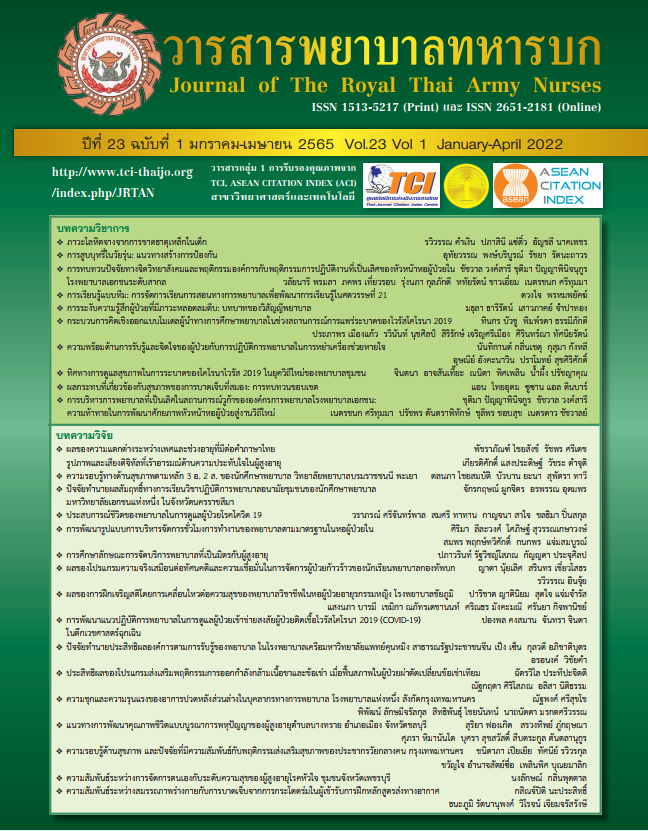Effects of Program Preoperative Instruction using Multimedia in Patients Receiving General Anesthesia
Keywords:
Program Preoperative Instruction Using Multimedia, Preoperation, General anesthesia, SatisfactionAbstract
This study is an experimental research. Aims to 1) Comparison of the data using video to the knowledge and practice of patients for patient preparation before receiving anesthesia in both 2) Satisfaction Study of the video. The conceptual framework of the theory of learning bloom (bloom, 1956) among patients who had been planning an operation of 50 divided into a control group and the experimental group, 25 in each group. A simple random sample was selected according to the list of surgical schedules. The instrument used in this study were 1) collecting data, 2) evaluate the knowledge and practice of patients receiving anesthesia in both 3) satisfaction of patients on videotape. Which were reviewed by a panel of experts and by the reliability coefficient alpha Cronbach (Cronbach’s alpha coefficient) was 0.85 by analysis of frequency distributions percent. The mean and standard deviation.
The results showed that 1) the level of knowledge and practice of patients receiving data normally at a good level ( = 13.60 SD = 1.4) the knowledge and behavior of patients participating in programs provided by the media VI. video of the trial at a good level ( = 13.76 SD = 1.2). 2) the level of knowledge and practice of patients who participate in the program by using the media to videotape the experimental group did not differ from the control group (t = 0.15, p = 0.685). 3) the satisfaction of patients, the media video to prepare patients prior to anesthesia medication either. The level of satisfaction is very high. This research shows. The information provided by the media, video on knowledge and practice of patient’s preparation before the patients received anesthesia in the body. No difference was statistically significant. However, the information provided by the media that patient satisfaction and still the roles of nurse anesthetists.
Downloads
References
Nigussie S, Belachew T, Wolancho W. Predictors of preoperative anxiety among surgical patients in Jimma University specialized eaching hospital, South Western Ethiopia. BMC surgery. 2014; 14(1): 1-10.
Iamrod, N., Sindhu, S., Danaidutsadeekul, S., Tantiwongkosri, K. Predictors of Delirium in the Elderly Patients Undergone Open Heart Surgery in the First 72 Hours After Surgery. J Royal Thai Army Nurses. 2016; 17(2): 34-42. (In Thai)
Bailey L. Strategies for decreasing patient anxiety in the perioperative setting. AORN journal. 2010; 92(4): 445-60.
Guo P, East L, Arthur A. A preoperative education intervention to reduce anxiety and improve recovery among Chinese cardiac patients: a randomized controlled trial. International journal of nursing studies. 2012; 49(2): 129-37.
Iqbal U, Green JB, Patel S, Tong Y, Zebrower M, Kaye AD, Urman RD, Eng MR, Cornett EM, Liu H. Preoperative patient preparation in enhanced recovery pathways. Journal of anaesthesiology, clinical pharmacology. 2019; 35(Suppl 1): S14-23.
Bloom BS. Taxonomy of educational objectives. Vol. 1: Cognitive domain. New York: McKay. 1956;20(24):1.
Mawhinney G, Thakar C, Williamson V, Rothenfluh DA, Reynolds J. Oxford Video Informed Consent Tool (OxVIC): A pilot study of informed video consent in spinal surgery and preoperative patient satisfaction. BMJ open. 2019; 9(7): e027712.
Boonchuduang S, Juthasantikul W, Chantarokorn A, Wasinwong W. Effects of using video guided about deep-breathing exercise for patient preparation before receiving general anesthesia. Srinagarind Medical Journal. 2012; 27(2): 139-46.
Tantranont, K., Suriyawong, W., Sripetchwandee, N., Tuanrat, W., Budda, D., Narin,R., Songkham, R., Development of Video Media of School Health Services. J Royal Thai Army Nurses. 2019; 20(1): 293-9. (In Thai)
K Natthanan, P Wilawan, K Areewan. The effect of providing information using video media on knowledge and practice of patients in prevention of nosocomial. Nursing J. 2011; 38(3): 98-109.
Cakmak M, Kose I, Zinzircioglu C, Karaman Y, Tekgul ZT, Pektas S, Balik Y, Gonullu M, Bozkurt PS. Effect of video-based education on anxiety and satisfaction of patients undergoing spinal anesthesia. Revista brasileira de anestesiologia. 2018; 68(3): 274-9.
Yesilyurt DS, Findik ÜY. Effect of Preoperative Video Information on Anxiety and Satisfaction in Patients Undergoing Abdominal Surgery. CIN: Computers, Informatics, Nursing. 2019; 37(8): 430-6.
Hounsome J, Lee A, Greenhalgh J, Lewis SR, Schofield-Robinson OJ, Coldwell CH, Smith AF. A systematic review of information format and timing before scheduled adult surgery for peri-operative anxiety. Anaesthesia. 2017; 72(10): 1265-72.
Narimatsu H, Kakinuma A, Sawa T, Komatsu T, Matsumura T, Kami M, Nakata Y. Usefulness of a bidirectional e-learning material for explaining surgical anesthesia to cancer patients. Annals of oncology. 2011; 22(9): 2121-8.
Downloads
Published
How to Cite
Issue
Section
License
Copyright (c) 2022 Journal of The Royal Thai Army Nurses

This work is licensed under a Creative Commons Attribution-NonCommercial-NoDerivatives 4.0 International License.
บทความหรือข้อคิดเห็นใดใดที่ปรากฏในวารสารพยาบาลทหารบกเป็นวรรณกรรมของผู้เขียน ซึ่งบรรณาธิการหรือสมาคมพยาบาลทหารบก ไม่จำเป็นต้องเห็นด้วย
บทความที่ได้รับการตีพิมพ์เป็นลิขสิทธิ์ของวารสารพยาบาลทหารบก
The ideas and opinions expressed in the Journal of The Royal Thai Army Nurses are those of the authors and not necessarily those
of the editor or Royal Thai Army Nurses Association.






